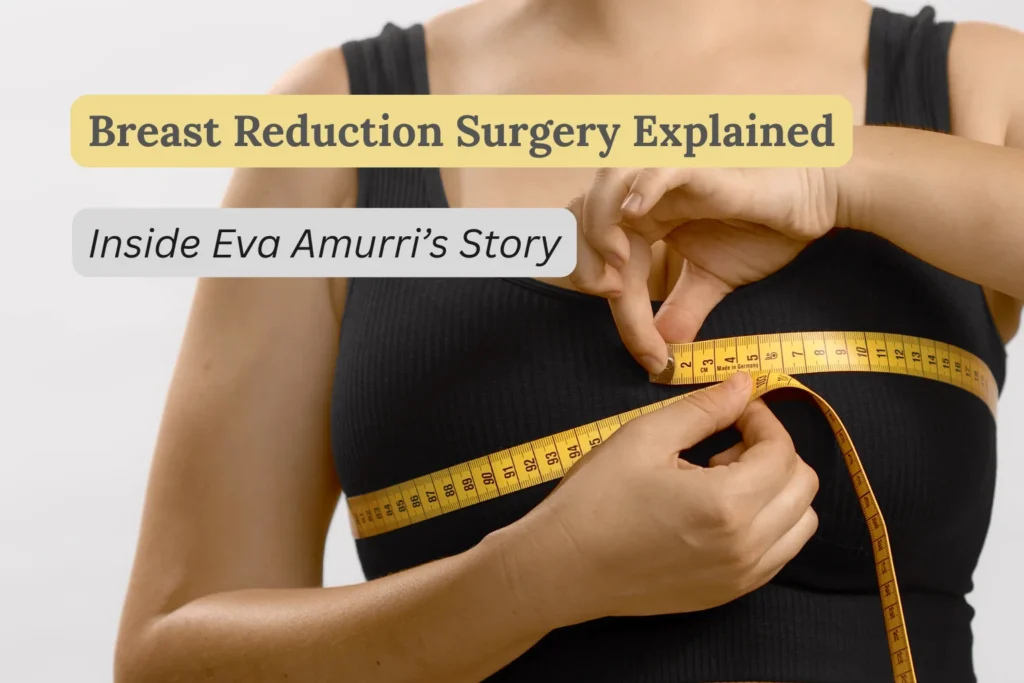Breast Reduction Story of Eva Amurri
When actress Eva Amurri, daughter of Susan Sarandon and filmmaker Franco Amurri, posted about her breast reduction surgery on Instagram, the comments were flooded with questions, support, and stories.

On 8th August 2025, she posted a side-by-side before-and-after video wearing the same striped bralette. Six months apart, the difference was obvious. She went from a 32F/G to a 32C, she said, and it’s changed her daily life.
Her caption was funny and telling:
“My back hurts looking at the first clip 🙃🫠”.
She said:
- Anchor scars are minimal thanks to a scar-minimizing protocol from her surgeon, Dr. Umbareen Mahmood, MD.
- Recovery wasn’t nearly as painful or long as she thought.
- She’s got better posture and less back strain.
This wasn’t the first time she’s shared updates. In April, Amurri posted photos of her bruising during healing and said sleeping upright was “the worst part” of recovery. She experimented with different supports, starting with a wedge pillow, then a neck pillow, and finally a pregnancy pillow.
Her honesty went beyond the physical. She called the weeks after surgery a time to “be kind to myself and nurture myself” – a message many followers found empowering.
Her openness about the process – including anchor scars and recovery – resonated with women dealing with the physical strain of large breasts.
Data from the American Society of Plastic Surgeons (ASPS) shows that in 2022, more than 43,000 breast reduction surgeries took place in the U.S., with the majority aimed at addressing health concerns rather than purely cosmetic goals.
Why Women Consider Breast Reduction Surgery
Breast reduction is often misunderstood as purely cosmetic. In reality, most women get it for medical and quality-of-life reasons.
Common motivations include:
- Chronic pain in the back, neck, and shoulders.
- Grooves from bra straps cutting into skin.
- Posture issues from forward shoulder pull.
- Skin irritation or rashes under the breast fold.
- Can’t exercise comfortably.
- Limited clothing choices and self-consciousness.
What is Breast Reduction Surgery
Also called reduction mammoplasty, breast reduction surgery removes excess breast tissue, fat, and skin to create a smaller, lighter, more proportionate breast size.
It’s different from a breast lift or augmentation:
- Reduction: Makes breasts smaller and lighter.
- Lift: Raises breasts without changing size much.
- Augmentation: Increases breast size with implants.
Why It’s Done – The Benefits
Many women get breast reduction for health, comfort, and lifestyle reasons.
Physical Health Benefits
- Relief from back, neck, and shoulder pain.
- Less skin irritation under the breasts.
- Better posture.
- Easier breathing and physical activity.
Emotional & Lifestyle Benefits
- Better-fitting clothes.
- More exercise and sports.
- Boost in self-confidence and body image.
Case: Eva’s surgery improved her posture and reduced her back pain almost immediately.
Risks & Considerations
Like any surgery, breast reduction also has a few potential risks:
- Scarring: Anchor or lollipop patterns; usually fade with time and care.
- Infection or wound healing issues.
- Nipple sensation changes (temporary or permanent).
- Breastfeeding challenges in the future.
- Asymmetry of healing varies.
How to reduce risks: Choose a board certified plastic surgeon with experience, follow all pre and post op instructions, and commit to scar care.
Eva’s “anchor scars” are a reminder that every surgery leaves a mark — but with proper care, these can be minimal.
Step-by-Step: The Breast Reduction Surgery Process
Understanding each step can help reduce anxiety, set realistic expectations, and make you feel more in control of your decision.
1. Pre-Surgery Consultation
The process begins with an in-depth consultation with a board-certified plastic surgeon experienced in breast surgeries, where they assess your overall health and discuss your personal goals for the procedure.
- Medical History Review: Your surgeon will ask you detailed questions about your overall health, past surgeries, allergies, current medications, and any chronic conditions. They’ll also want to know about symptoms related to large breasts, such as back or neck pain, skin irritation, or posture problems.
- Physical Examination: This involves measuring your breasts, noting skin quality, and evaluating the placement of your nipples and areolas.
- Imaging Tests: Depending on your age and risk factors, your surgeon may recommend a mammogram or ultrasound to get a clear view of your breast tissue before surgery.
- Goal Discussion: This is where you discuss what you want, not just in terms of size but also shape, symmetry, and proportion. Your surgeon will explain which incision types may be appropriate and what results you can realistically expect based on your anatomy.
2. Pre-Op Preparation
In the weeks before your surgery, preparation is key to a smooth operation and recovery.
- Medication Adjustments: You may need to stop taking certain drugs that thin the blood, such as aspirin or anti-inflammatory medications, to reduce the risk of bleeding. Always do this under your doctor’s guidance.
- Lifestyle Changes: If you smoke, your surgeon will require you to quit at least six weeks before and after surgery.
- Support at Home: Arrange for someone you trust to drive you home after surgery and stay with you for at least the first 24-48 hours. Having help with basic tasks like meal prep and household chores can make recovery much easier.
3. Anesthesia
On the day of your surgery, General anesthesia is usually used, meaning you’ll be completely asleep and pain-free for the entire procedure. In some cases, deep sedation may be an option, but general anesthesia is the standard for most breast reductions to ensure safety and comfort.
4. Incision Types
The incision method your surgeon chooses will depend on factors like your breast size, how much tissue needs to be removed, and the results you’re hoping to achieve.
- Anchor Incision: Extends around the areola, vertically down to the breast crease, and horizontally along the crease. This is ideal for larger reductions and provides maximum reshaping control.
- Lollipop Incision: Goes around the areola and vertically down to the breast crease. It’s used for moderate reductions and offers a good balance between tissue removal and limited scarring.
- Donut Incision: Encircles only the areola and is typically reserved for smaller reductions or lifts where minimal skin removal is needed.
5. Tissue Removal & Reshaping
Once the incisions are made, the surgeon carefully removes excess glandular tissue, fat, and skin. The amount removed will depend on your goals, physical proportions, and the need to relieve symptoms like pain or skin irritation.
After removing the excess, the surgeon reshapes the remaining tissue to create a natural, lifted contour. In most cases, the nipple–areola complex is repositioned higher on the breast for improved proportion.
This reshaping stage is where surgical artistry meets medical precision — the goal is to achieve symmetry, proportion, and a natural appearance.
6. Closure
Once the reshaping is complete, the surgeon closes the incisions with sutures, typically layered beneath the skin to support the new breast shape. Skin adhesives or surgical tape may be applied to protect the surface and support healing.
In some cases, small surgical drains are placed near the incision sites to help remove excess fluid or blood during the first few days.
After closure, your breasts will be dressed with sterile bandages and supported by a surgical bra or compression garment.
Recovery: What to Expect Day by Day
| First 48 Hours | – Bandages or dressings applied- Support bra worn to minimize swelling- Pain managed with prescribed medication |
| Week 1 | – Movement restricted- Short walks encouraged to prevent clots- Sleeping upright recommended |
| Week 2–3 | – Stitches may be removed (if not absorbable)- Most patients return to desk work- Bruising and swelling begin to subside |
| Week 4–6 | – Resume light exercise- Continue wearing support bra |
| 3–6 Months | – Scars lighten in color- Breast shape stabilizes |
| 12 Months | – Final results visible- Scars fully matured (flat, pale) |
Breast Reduction Scars – Managing and Minimizing
Types: Anchor, lollipop, periareolar.
Scar Care:
- Silicone gel/sheets.
- Gentle massage once healed.
- SPF protection daily.
Eva credits her minimal scars to a proactive scar protocol from her surgeon.
Choosing the Right Surgeon
Look for:
- Board certification from the American Board of Plastic Surgery.
- Before-and-after portfolio.
- Experience with different incision types.
- Positive patient testimonials.
- Hospital privileges for safety.
Breast Reduction Surgery Cost in the US
| Surgeon’s Fee | $5,000 – $8,000 | Experience & city affect cost |
| Anesthesia | $800 – $1,500 | General anesthesia |
| Facility Fee | $1,200 – $2,500 | Hospital or surgical center |
| Medical Tests | $100 – $300 | Pre-op labs/imaging |
| Medications | $50 – $200 | Pain meds, antibiotics |
| Post-Surgery Garments | $50 – $150 | Support bras |
| Total | $7,200 – $12,650 | Insurance may cover if medically necessary |
The ASPS confirms insurance coverage is common when symptoms are documented.
FAQs – Breast Reduction Surgery
Q1: Is breast reduction surgery painful?
Mild to moderate discomfort; manageable with medication.
Q2: How long do scars take to fade?
6–12 months with proper care.
Q3: Can I breastfeed after surgery?
Possible, but not guaranteed, depends on surgical technique.
Q4: What’s the recovery time?
Light activity in 2 weeks; full in 6–12 weeks.
Q5: Does insurance cover it?
Often yes, if medically necessary and documented.
Q6: Will my breasts grow back?
Significant weight gain, pregnancy, or hormonal changes can affect size.
Final Word
Eva Amurri’s openness made an often-private decision public, and in doing so, she gave many women the courage to ask questions about breast reduction surgery.
If you’re considering it, remember:
- It’s about comfort, mobility, and self-confidence.
- Preparation and the right surgeon matter.
- The results can be life-changing, both physically and emotionally.



